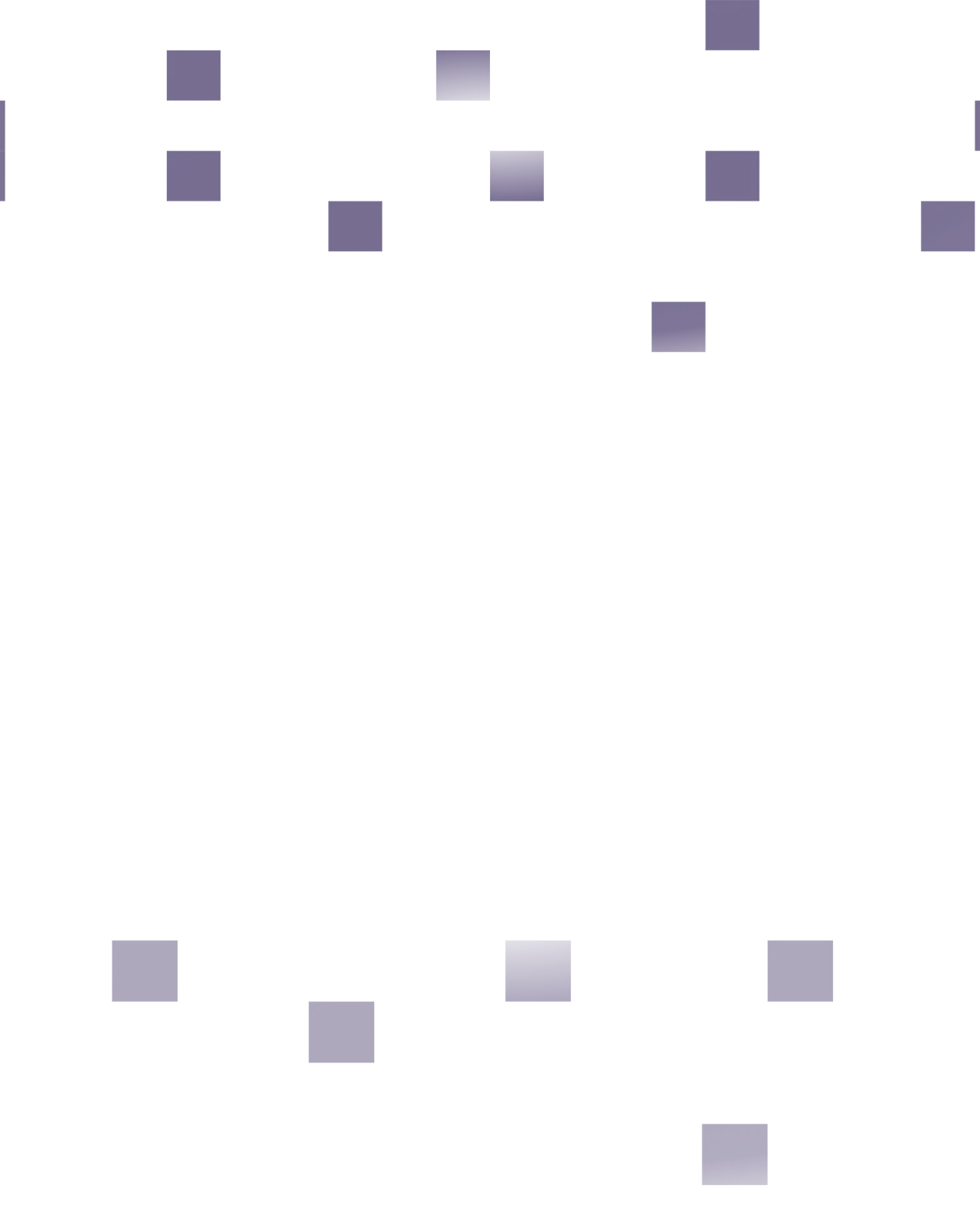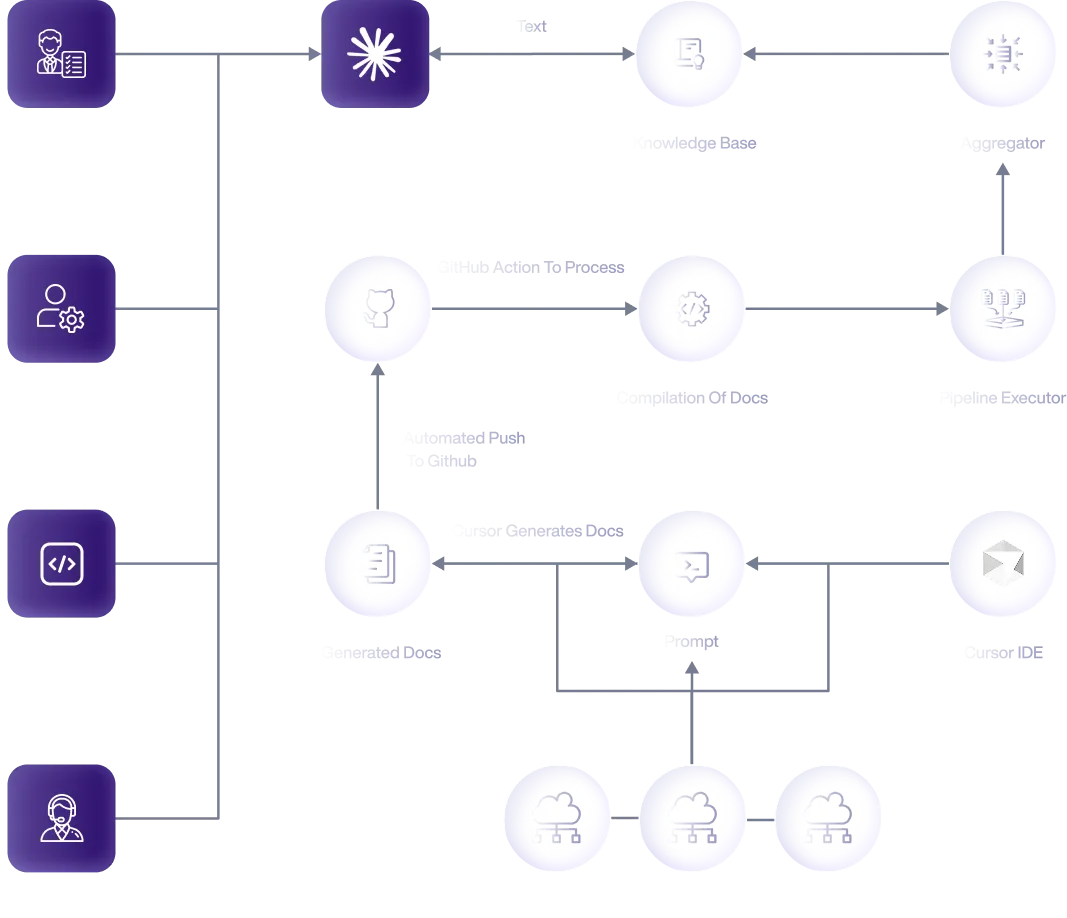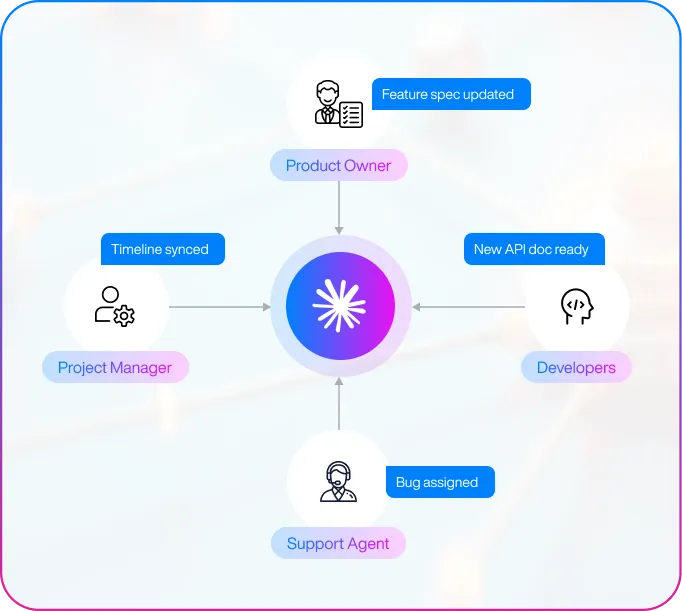About the Project
TechCare.Inc successfully developed an AI-powered chatbot interface that revolutionizes Product Knowledgebase with the onboarding experience for Product Owners, Project Managers, Developers, and Client Support Agents. By leveraging Claude Projects, Cursor IDE, and GitHub Actions, we created a dynamic, context-aware system that maintains an always-current knowledge base while delivering personalized interactions for each user group.
Performance Highlights
85%
Onboarding Time Reduction
75%
Faster Problem Resolution
90%+
Accuracy Maintained
4.6/5
User Satisfaction
The Challenges
TechCare faced a complex requirement: build an intelligent interface capable of serving four distinct stakeholder groups simultaneously, each with unique needs and communication preferences. The system needed to:
User Experience


Multi-Stakeholder Support



Information Handling



Knowledge Management



Functional Capabilities




Benefits Achieved
Our initial approach considered building a custom chatbot from scratch. However, this presented significant challenges:
Context Comprehension: The volume and complexity of contextual information required sophisticated natural language understanding
Accuracy Requirements: The diverse nature of queries demanded high precision across technical and business domains
Maintenance Burden: Keeping the system current with continuous codebase changes would require substantial ongoing effort
Development Timeline: Building such capabilities would significantly delay deployment
The Claude Projects Solution
After evaluating various approaches, we identified Claude Projects as the ideal foundation for our solution. Claude's capabilities aligned perfectly with our requirements:
Advanced Context Processing: Native ability to understand and utilize extensive documentation
Natural Language Understanding: Sophisticated comprehension of both technical and conversational queries
Knowledge Integration: Seamless integration of multiple information sources into a unified knowledge base
Solution Architecture
Information Extraction Pipeline
The core challenge involved creating an automated system to extract meaningful information from our microservice repositories. Our pipeline identifies and documents:
Architectural Patterns
API Documentation
Data Flow Analysis
Configuration Management
Repository Documentation
Implementation Workflow
Phase 1: Executive Prompt Engineering
We developed and refined a comprehensive prompt engineering strategy through extensive testing. This "executive prompt" serves as the blueprint for documentation generation, guiding the automated extraction process with specific instructions for:
Phase 2: Automated Documentation Generation
Integration with Cursor IDE enables developers to:
Phase 3: Centralized Aggregation
All generated documentation is:
Phase 4: Knowledge Base Construction
A specialized aggregation pipeline:
Phase 5: Continuous Integration
GitHub Actions automate the entire pipeline:

System Architecture

Results and Benefits
Operational Efficiency
Reduced Onboarding Time: 85% reduction—from 2 weeks to 3 days for new team members.
Decreased Support Burden: 70% fewer repetitive inquiries, freeing up senior staff for high-value work.
Faster Problem Resolution: 75% improvement—average resolution time dropped from 4 hours to 45 minutes.
Knowledge Continuity
Always-Current Documentation: 90%+ accuracy maintained automatically versus 40% with manual processes.
Centralized Information: Single source of truth across 25+ repositories serving 50+ team members.
Preserved Institutional Knowledge: 100% capture of architectural decisions and design patterns.
User Satisfaction
Personalized Interactions: 4.6/5.0 user satisfaction rating across all stakeholder groups.
24/7 Availability: 200+ queries per week handled with 92% first-response accuracy.
Comprehensive Coverage: 88% of queries resolved without human escalation.
Developer Productivity
API Discovery: 90% time savings—learning curve reduced from 2-3 days to 2-3 hours.
Pattern Recognition: 35% acceleration in feature development speed.
Reduced Context Switching: 6 hours per week saved per developer on documentation searches.
Key Learnings
Prompt Engineering is Critical
The quality of automated documentation depends heavily on well-crafted prompts
Automation Enables Currency
Manual documentation updates are unsustainable; automation is essential
Context Quality Over Quantity
Well-structured, relevant context outperforms exhaustive but disorganized information
Integration is Key
Seamless workflow integration ensures developer adoption and consistent documentation
Future Enhancements
Proactive Insights: Alert stakeholders to potential issues based on codebase analysis
Advanced Analytics: Track common queries to identify documentation gaps and training needs
Multi-Modal Interactions: Support for diagram generation and code visualization
Integration Expansion: Connect with project management tools, issue trackers, and CI/CD pipelines
Conclusion
By combining Claude Projects with intelligent automation through Cursor IDE and GitHub Actions, the solution demonstrates how modern AI capabilities, when properly architected and integrated, can dramatically improve organizational knowledge management and operational efficiency.





